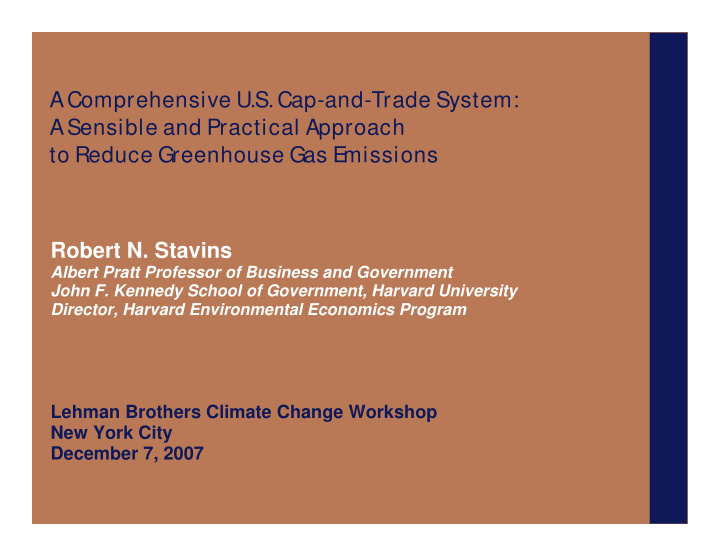



A Comprehensive U.S. Cap-and-Trade System: A Sensible and Practical Approach to Reduce Greenhouse Gas E missions Robert N. Stavins Albert Pratt Professor of Business and Government John F. Kennedy School of Government, Harvard University Director, Harvard Environmental Economics Program Lehman Brothers Climate Change Workshop New York City December 7, 2007
INTRODUCTION INTRODUCTION INTRODUCTION � There’s a growing impetus for a domestic U.S. climate policy to provide meaningful reductions in CO 2 and other greenhouse gases � And general consensus among policy analysts that a market-based instrument targeting CO 2 emissions should be a central element � While there are tradeoffs between two MBIs – cap-and-trade system and carbon tax – best and most likely approach for short to medium term in the United States is a cap-and-trade system � Three criteria for policy assessment : environmental effectiveness, cost effectiveness, and distributional equity 2 2
Key Merits of a Cap- -and and- -Trade Approach Trade Approach Key Merits of a Cap Key Merits of a Cap-and-Trade Approach � Provides a cost-effective means of achieving meaningful emissions reductions � Offers an easy means of compensating for the inevitably unequal burdens imposed by a climate policy � Provides a straightforward means to link and harmonize with other countries’ climate policies � Unlikely to be degraded – in terms of environmental performance and cost effectiveness – by political forces � Has a history of successful adoption and implementation in the United States over the past two decades 3 3
Proposal for a U.S. Cap- -and and- -Trade System Trade System Proposal for a U.S. Cap Proposal for a U.S. Cap-and-Trade System � Upstream, economy-wide CO 2 cap-and-trade system, with gradual inclusion of other greenhouse gases (and offsets for carbon capture & storage) � Gradual downward trajectory of emissions ceilings over time, to minimize disruption and allow firms and households time to adapt � Mechanisms to reduce cost uncertainty (price volatility): banking, borrowing, and a sensible cost-containment mechanism � Initially, half of the program’s allowances allocated through auction and half through free distribution, moving to 100% auction within 25 years � Free distribution targeted at entities most burdened by policy -- helps limit potential inequities while bolstering political support � Auction generates revenue for worthwhile public purposes: compensation, R&D, reduction of Federal deficit, and/or reduction of distortionary taxes � Linkage with international emission reduction credits, and harmonization over time with cap-and-trade systems in other countries � Appropriate linkage with actions taken abroad to maintain a level playing field between imports and import-competing domestic products. 4 4
Comparison w ith Alternatives Comparison w ith Alternatives Comparison w ith Alternatives � Alternative to cap-and-trade most frequently considered by policy makers for CO 2 & other GHG reductions is standards-based policy � Inferior to CAT (and carbon taxes) in terms of environmental effectiveness, cost effectiveness, and distributional equity � Among some economists and other policy analysts, there is interest in use of carbon taxes � Most of the critiques of cap-and-trade use straw-man caricatures � Environmental effectiveness: tax does not guarantee achievement of emissions target (but provides greater certainty regarding costs) – fundamental tradeoff � Taxes provide automatic temporal flexibility; need to build in to CAT � But, political economy forces strongly point to less severe targets if carbon taxes are used, rather than cap-and-trade – not a tradeoff � This is why environmental NGOs are opposed to taxes. 5 5
Comparison of Cap- -and and- -Trade & Carbon Tax Trade & Carbon Tax Comparison of Cap Comparison of Cap-and-Trade & Carbon Tax � In principle, both can achieve cost-effective reductions. � Distributional consequences of two approaches can be identical � But political pressures on carbon tax system lead to exemptions of sectors/firms , which reduces environmental effectiveness and drives up costs � Political pressures on cap-and-trade system lead to different allocations of allowances , which affect only distribution, not environmental effectives, not cost effectiveness � So, some observers worry about propensity of political process under a CAT system to compensate sectors (through free allowances allocations) � But a carbon tax is sensitive to the same pressures, and may be expected to succumb in ways that are ultimately more harmful. � It is important to design policy that is “optimal in Washington,” not just from perspective of Cambridge, New Haven, or Berkeley. 6 6
To help identify key design elements of a scientifically sound, economically rational, and politically pragmatic post-2012 international policy architecture for global climate change, drawing upon leading thinkers from academia, private industry, government, and non-governmental organizations. 7 7
For More Information Harvard Project on International Climate Agreements www.belfercenter.org/climate Proposal for a U.S. Cap-and-Trade System www.brookings.edu/papers/2007/10climate_stavins.aspx or The Harvard Environmental Economics Program or www.stavins.com 8 8
Recommend
More recommend